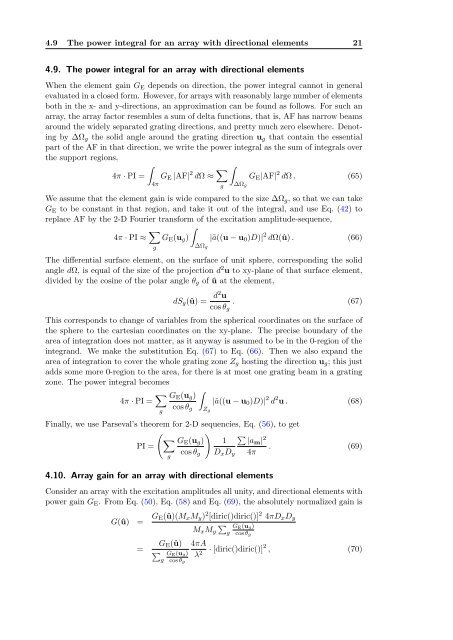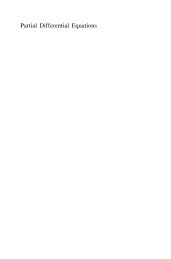a Matlab package for phased array beam shape inspection
a Matlab package for phased array beam shape inspection
a Matlab package for phased array beam shape inspection
Create successful ePaper yourself
Turn your PDF publications into a flip-book with our unique Google optimized e-Paper software.
4.9 The power integral <strong>for</strong> an <strong>array</strong> with directional elements 21<br />
4.9. The power integral <strong>for</strong> an <strong>array</strong> with directional elements<br />
When the element gain G E depends on direction, the power integral cannot in general<br />
evaluated in a closed <strong>for</strong>m. However, <strong>for</strong> <strong>array</strong>s with reasonably large number of elements<br />
both in the x- and y-directions, an approximation can be found as follows. For such an<br />
<strong>array</strong>, the <strong>array</strong> factor resembles a sum of delta functions, that is, AF has narrow <strong>beam</strong>s<br />
around the widely separated grating directions, and pretty much zero elsewhere. Denoting<br />
by ∆Ω g the solid angle around the grating direction u g that contain the essential<br />
part of the AF in that direction, we write the power integral as the sum of integrals over<br />
the support regions,<br />
∫<br />
4π · PI = G E |AF| 2 dΩ ≈ ∑ ∫<br />
G E |AF| 2 dΩ . (65)<br />
4π g ∆Ω g<br />
We assume that the element gain is wide compared to the size ∆Ω g , so that we can take<br />
G E to be constant in that region, and take it out of the integral, and use Eq. (42) to<br />
replace AF by the 2-D Fourier trans<strong>for</strong>m of the excitation amplitude-sequence,<br />
4π · PI ≈ ∑ ∫<br />
G E (u g ) |ã((u − u 0 )D)| 2 dΩ(û) . (66)<br />
g<br />
∆Ω g<br />
The differential surface element, on the surface of unit sphere, corresponding the solid<br />
angle dΩ, is equal of the size of the projection d 2 u to xy-plane of that surface element,<br />
divided by the cosine of the polar angle θ g of û at the element,<br />
dS g (û) =<br />
d2 u<br />
cos θ g<br />
. (67)<br />
This corresponds to change of variables from the spherical coordinates on the surface of<br />
the sphere to the cartesian coordinates on the xy-plane. The precise boundary of the<br />
area of integration does not matter, as it anyway is assumed to be in the 0-region of the<br />
integrand. We make the substitution Eq. (67) to Eq. (66). Then we also expand the<br />
area of integration to cover the whole grating zone Z g hosting the direction u g ; this just<br />
adds some more 0-region to the area, <strong>for</strong> there is at most one grating <strong>beam</strong> in a grating<br />
zone. The power integral becomes<br />
4π · PI = ∑ g<br />
G E (u g )<br />
cos θ g<br />
∫<br />
Z g<br />
|ã((u − u 0 )D)| 2 d 2 u . (68)<br />
Finally, we use Parseval’s theorem <strong>for</strong> 2-D sequencies, Eq. (56), to get<br />
( )<br />
∑<br />
∑<br />
G E (u g ) 1 |am | 2<br />
PI =<br />
. (69)<br />
cos θ<br />
g g D x D y 4π<br />
4.10. Array gain <strong>for</strong> an <strong>array</strong> with directional elements<br />
Consider an <strong>array</strong> with the excitation amplitudes all unity, and directional elements with<br />
power gain G E . From Eq. (50), Eq. (58) and Eq. (69), the absolutely normalized gain is<br />
G(û) = G E(û)(M x M y ) 2 [diric()diric()] 2 4πD x D y<br />
M x M y<br />
∑g<br />
=<br />
G E (û)<br />
∑ G E (u g)<br />
g cos θ g<br />
G E (u g)<br />
cos θ g<br />
4πA<br />
λ 2 · [diric()diric()] 2 , (70)
















